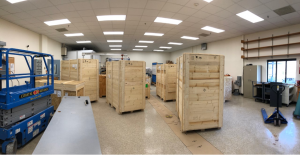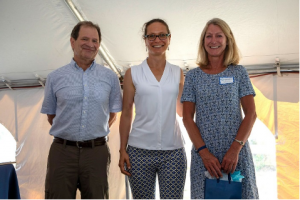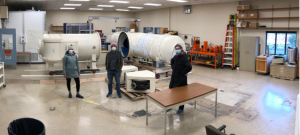Latest News
Happy Holidays from NOSAMS
The past six months have been very busy at the NOSAMS facility. In September we hosted a MICADAS workshop that brought together 42 people from 18 international institutions at WHOI, plus an additional 38 online participants.
Mark Roberts has recently retired after 22+ productive years as Staff Physicist with the facility. We are happy to report he will maintain an Emeritus role at NOSAMS.
Last week we hosted an Introduction to Radiocarbon workshop in Washington, D.C. prior to the AGU Fall Meeting. Attendees had the opportunity to practice sampling and discuss issues ranging from preventing contamination to nomenclature.
Our fees will be increasing effective April 2025. The new fee chart can be found on our website.
Highlights from the recent literature
Lester, J. G., Graven, H. D., Khatiwala, S., McNichol, A.P. (2024) Changes in Oceanic Radiocarbon and CFCs Since the 1990s.” Journal of Geophysical Research-Oceans 129, e2023JC020387. https://doi.org/10.1029/2023JC020387
McHugh, C. M., Seeber, L., Gulick, Sean P.S., et al. (2024) Sedimentary signatures of large earthquakes along the submerged Enriquillo−Plantain Garden transpressional plate boundary, northern Caribbean.” Geology . https://doi.org/10.1130/G52258.1
Goldstein, S. T., Mueller, N. G., Janzen, A., et al. (2024) Early agriculture and crop transitions at Kakapel Rockshelter in the Lake Victoria region of eastern Africa.” Proceedings of the Royal Society B: Biological Sciences, no. 2026 : 20232747. https://doi.org/10.1098/rspb.2023.2747
A full bibliography of publications utilizing NOSAMS analyses can be found here.
|
||||||||||||
|
Dear Friends of NOSAMS,
These past few months have been a productive time at NOSAMS and we are writing to update you on recent changes.
We are excited to announce that we have purchased a new MIni CArbon DAting System (MICADAS), manufactured by IonPlus, with funds from a successful NSF MRI proposal and WHOI cost sharing. It was installed in April, 2022 and passed final site acceptance tests in July, 2022. Samples can be introduced as graphite or via the Gas Interface System (GIS) with an Elemental Analyzer for organic samples or with a Carbonate System for inorganic samples. Over the next several months we will be offering these lower cost, lower precision carbonate and ready-to-burn organic carbon analyses using the hybrid gas interface MICADAS peripherals. Please contact us at nosams@whoi.edu for details. Thank you to NSF and the radiocarbon community for their support!
After 7 years of distinguished service, Dr. Mark Kurz has stepped down as NOSAMS Director and Dr. Susan Lang has taken up the post. The staff is very grateful to Mark who helped steer the facility through key staffing changes, the pandemic, and the funding of the MICADAS.
Dr. Susan Lang started as the new NOSAMS Director in May, 2022. She has a strong background using radiocarbon in the areas of dissolved organic carbon and compound specific analyses of small polar molecules. She has a long-standing interest in developing new radiocarbon and stable carbon methods.
As always, please visit our website for more information on all of our current services and fees.
All the best, the NOSAMS Facility Staff
We are excited to announce that we have purchased a new MIni CArbon DAting System (MICADAS), manufactured by IonPlus, with funds from a successful NSF MRI proposal and WHOI cost sharing. It was installed in April, 2022 and passed final site acceptance tests in July, 2022. Samples can now be introduced as graphite or via the Gas Interface System (GIS) with an Elemental Analyzer for organic samples or with a Carbonate Handling System for inorganic samples. Over the next several months we will be starting to offer lower cost, lower precision carbonate and ready-to-burn organic carbon analyses using the hybrid gas interface MICADAS peripherals.
Thank you to NSF and the radiocarbon community for their support!

MICADAS, the early days
Sue Handwork was recently recognized at the WHOI Employee Appreciation Celebration for her 40 years of service, of which 28 have been at NOSAMS. Also recognized were Mark Roberts (20 years), Mary Lardie Gaylord (20 years) and Kalina Gospodinova (10 years). Congratulations and thank you to all of these hard working, long serving NOSAMS staff.

Sue Handwork (right) receiving recognition for her 40 years of service to WHOI. Also pictured are the recent NOSAMS Director Dr. Mark Kurz (left) and current NOSAMS Director Dr. Susan Lang (middle).
After 7 years of distinguished service, Dr. Mark Kurz has stepped down as NOSAMS Director and Dr. Susan Lang has taken up the post. The staff is very grateful to Mark who helped steer the facility through key staffing changes, the pandemic, and a successful proposal to the NSF Major Research Initiative to fund a new MIni CArbon DAting System (MICADAS), manufactured by IonPlus.
Dr. Susan Lang started as the new NOSAMS Director in May, 2022. She has a strong background using radiocarbon in the areas of dissolved organic carbon and compound specific analyses of small polar molecules. She has a long-standing interest in developing new radiocarbon and stable carbon methods.
In preparation for the installation of a new AMS system, we had to dismantle the USAMS system in December 2021 after 30 years of operations. We have retained the USAMS hybrid ion source and low energy magnet.

After 30 years of operations, the USAMS system was decommissioned to make room for the new MICADAS system.
NOSAMS is pleased to host the 2021 Symposium of Northeastern Accelerator Personnel (SNEAP). The meeting is May 3-5 and will be virtual.
SNEAP is a community of personnel involved with electrostatic particle accelerators and their use. Founded in 1968, the organization gathers annually to discuss and exchange information to the benefit of all who attend. The topics covered include ion sources, electrostatic and RF accelerators, telemetry and control systems, cryogenic systems, safety issues and many other topics relevant to the operation of small to medium sized electrostatic accelerator laboratories. The meeting format includes submitted papers, laboratory reports, and open discussions.
More information and registration is available on the conference website.

As COVID-19 cases in Massachusetts have declined, WHOI is beginning it’s phased opening plan. The institution will be open, but the campuses will still be closed and open only to those that have been approved.
NOSAMS continues to be open and to operate with a partial staff in this new re-opening phase while respecting conservative physical distancing as outlined by the Commonwealth of Massachusetts and WHOI policies. We are accepting and processing samples. NOSAMS does not expect an increase in turnaround times as a result of COVID-19. Please send questions or comments to nosams@whoi.edu.
